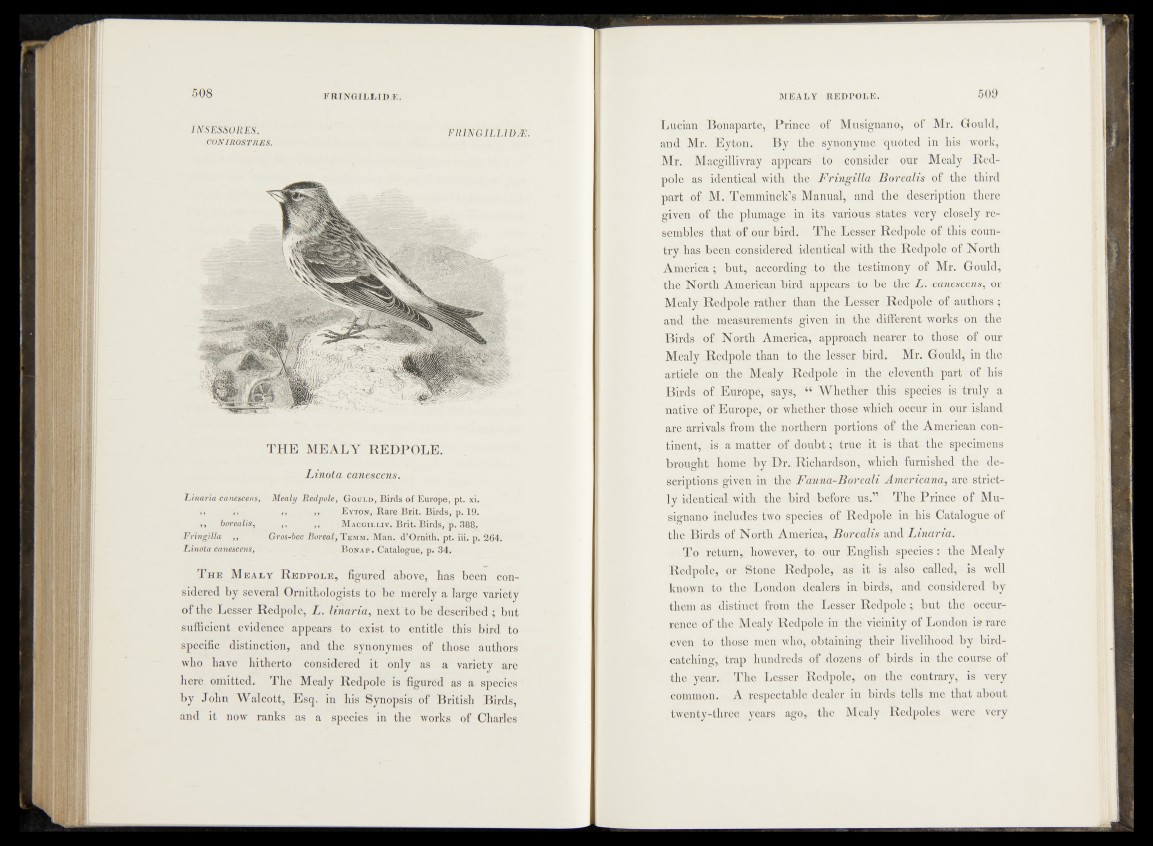
CONIROSTRES.
TH E MEALY REDPOLE.
Linota canescens.
INSESHORES.
F lU NG ILLW JE .
Linaria canescens, Mealy Redpole, G ould, Birds of Europe, pt. xi.
>> it it i , E yton, Rare Brit. Birds, p. 19.
,, borealis, ,, ,, M acgilliv. Brit. Birds, p . 388.
Fringilla ,, Gros-bec Boreal, T emm. Man. d’Ornith. pt. iii. p. 264.
Linota canescens, B onap. Catalogue, p. 34.
T h e M e a l y R e d p o l e , figured above, has been considered
by several Ornithologists to be merely a large variety
of the Lesser Redpole, L. linaria, next to be described ; but
sufficient evidence appears to exist to entitle this bird to
specific distinction, and the synonymes of those authors
who have hitherto considered it only as a variety are
here omitted. The Mealy Redpole is figured as a species
by John Walcott, Esq. in his Synopsis of British Birds,
and it now ranks as a species in the works of Charles
Lucian Bonaparte, Prince of Musignano, of Mr. Gould,
and Mr. Eyton. By the synonyme quoted in his work,
Mr. Macgillivray appears to consider our Mealy Redpole
as identical with the Fringilla Borealis of the third
part of M. Temminck’s Manual, and the description there
given of the plumage in its various states very closely resembles
that of our bird. The Lesser Redpole of this country
has been considered identical with the Redpole of North
America ; but, according to the testimony of Mr. Gould,
the North American bird appears to be the L. canescens, or
Mealy Redpole rather than the Lesser Redpole of authors ;
and the measurements given in the different works on the
Birds of North America, approach nearer to those of our
Mealy Redpole than to the lesser bird. Mr. Gould, in the
article on the Mealy Redpole in the eleventh part of his
Birds of Europe, says, “ Whether this species is truly a
native of Europe, or whether those which occur in our island
are arrivals from the northern portions of the American continent,
is a matter of doubt; true it is that the specimens
brought home by Dr. Richardson, which furnished the descriptions
given in the Fauna-Boreali Americana, are strictly
identical with the bird before us.” The Prince of Musignano
includes two species of Redpole in his Catalogue of
the Birds of North America, Borealis and Linaria.
To return, however, to our English species : the Mealy
Redpole, or Stone Redpole, as it is also called, is well
kno'wn to the London dealers in birds, and considered by
them as distinct from the Lesser Redpole ; but the occurrence
of the Mealy Redpole in the vicinity of London iff rare
even to those men who, obtaining their livelihood by bird-
catching, trap hundreds of dozens of birds in the course of
the year. The Lesser Redpole, on the contrary, is very
common. A respectable dealer in birds tells me that about
twenty-three years ago, the Mealy Redpoles were very